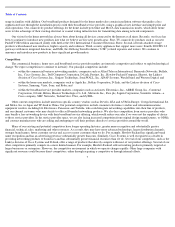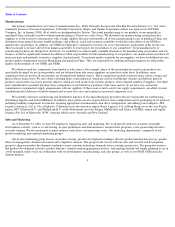Netgear 2010 Annual Report Download - page 19
Download and view the complete annual report
Please find page 19 of the 2010 Netgear annual report below. You can navigate through the pages in the report by either clicking on the pages listed below, or by using the keyword search tool below to find specific information within the annual report.
Table of Contents
We are subject to income taxes in the United States and numerous foreign jurisdictions. Our effective tax rate has fluctuated in the past and
may fluctuate in the future. Future effective tax rates could be affected by changes in the composition of earnings in countries with differing tax
rates, changes in deferred tax assets and liabilities, or changes in tax laws. In 2010, the current Administration issued its 2011 budget proposals
that included proposed changes in U.S. tax law that may adversely affect our tax rate if adopted.
We are also subject to examination by the Internal Revenue Service (“IRS”) and other tax authorities, including state revenue agencies and
foreign governments. While we regularly assess the likelihood of favorable or unfavorable outcomes resulting from examinations by the IRS and
other tax authorities to determine the adequacy of our provision for income taxes, there can be no assurance that the actual outcome resulting
from these examinations will not materially adversely affect our financial condition and operating results. Additionally, the IRS and other tax
authorities have increasingly focused attention on intercompany transfer pricing with respect to sales of products and services and the use of
intangible assets. Tax authorities could disagree with our intercompany charges, cross-jurisdictional transfer pricing or other matters and assess
additional taxes. Any such disagreements may affect our profitability.
We are subject to numerous governmental regulations concerning the manufacturing and use of our products. We must stay in
compliance with all such regulations and any future regulations. Any failure to comply with such regulations, and the unanticipated
costs of complying with future regulations, may adversely affect our business, financial condition and results of operations.
We manufacture and sell products which contain electronic components, and such components may contain materials that are subject to
government regulation in both the locations that we manufacture and assemble our products, as well as the locations where we sell our products.
An example of a regulated material is the use of lead in electronic components. To the best of our knowledge, we maintain compliance with all
current government regulations concerning the materials utilized in our products, for all the locations in which we operate. Since we operate on a
global basis, this is a complex process which requires continual monitoring of regulations and an ongoing compliance process to ensure that we
and our suppliers are in compliance with all existing regulations. There are areas where future regulations may be enacted which could increase
our cost of the components that we utilize. While we do not currently know of any proposed regulation regarding components in our products
which would have a material impact on our business, if there is an unanticipated new regulation which significantly impacts our use of various
components or requires more expensive components, that would have a material adverse impact on our business, financial condition and results
of operations.
Our manufacturing process is also subject to numerous governmental regulations, which cover both the use of various materials as well as
environmental concerns. To the best of our knowledge, we maintain compliance with all current government regulations concerning our
production processes, for all locations in which we operate. Since we operate on a global basis, this is also a complex process which requires
continual monitoring of regulations and an ongoing compliance process to ensure that we and our suppliers are in compliance with all existing
regulations. There are areas where future regulations may be enacted which could increase our cost of manufacture. One area which has a large
number of potential changes in regulations is the environmental area. Environmental areas such as pollution and climate change have had
significant legislative and regulatory efforts on a global basis, and there are expected to be additional changes to the regulations in these areas.
These changes could directly increase the cost of energy which may have an impact on the way we manufacture products or utilize energy to
produce our products. In addition, any new regulations or laws in the environmental area might increase the cost of raw materials we use in our
products. Other regulations in the environmental area may require us to continue to monitor and ensure proper disposal or recycling of our
products. While future changes in regulations appears likely, we are currently unable to predict how any such changes will impact us and if such
impacts will be material to our business. If there is a new law or regulation that significantly increases our costs of manufacturing or causes us to
significantly alter the way that we manufacture our products, this would have a material adverse affect on our business, financial condition and
results of operations.
17
























